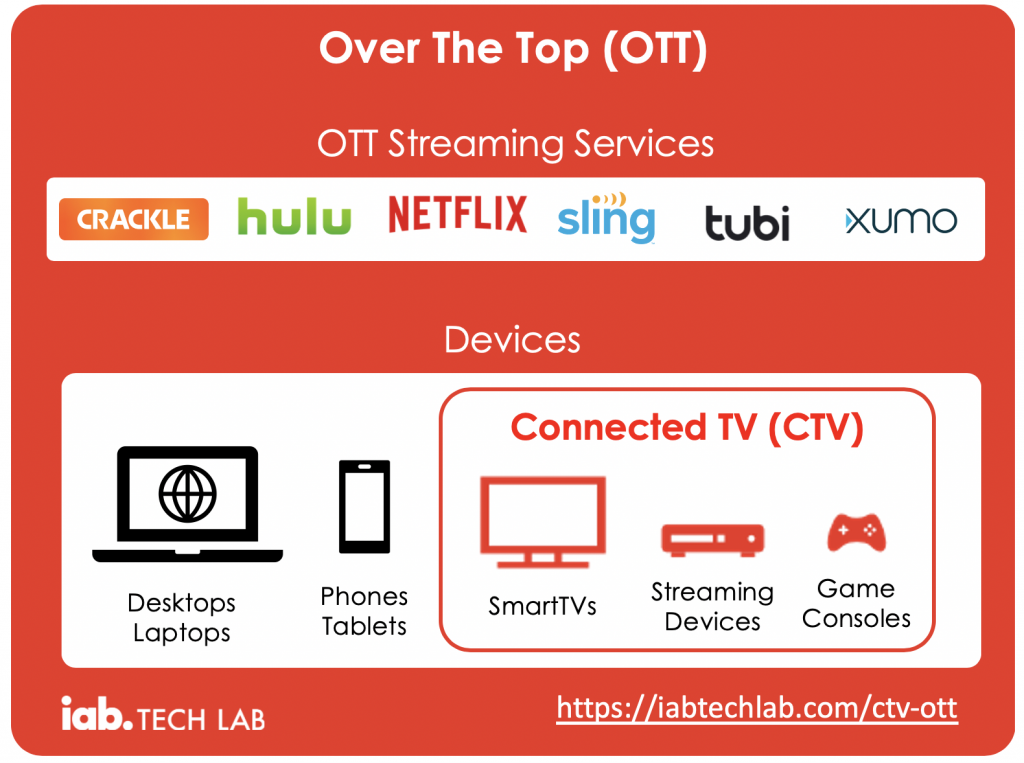Executive Summary
- Use CTV to refer to a specific type of device
- Use OTT to refer to content
Over the last few years, streaming services have exploded and have made the terms “OTT” and “CTV” (defined below) popular. Unfortunately, people also tend to use them interchangeably, which is fine for casual conversations, but makes for some real confusion when we need to be specific. Common questions I hear include:
- “When you say ‘OTT’, did you mean Smart TVs or do you also mean mobile apps?”
- “Does that also include AppleTV and Chromecast?”
The members of the current “OTT” Technical Working Group have had to deal with this confusion a lot. In fact, when we released the guidance for handling User Agents and for using Application IDs, we had to provide language that hedged our bets across OTT and CTV by using “OTT/CTV” where possible.
Similarly, in recent times the concept of “OTT fraud” sparks a lot of conversations. The challenges we face on mobile and desktop are very different from those we face on CTV devices. People immediately need to know exactly what we mean when a phrase like “OTT fraud” is thrown around. Are we really talking OTT, or are we seeing fraud in CTV as well?
We would like to move the conversation in a more productive direction by clarifying the origins and usage of these terms.
OTT : Over-The-Top Video
The term “over the top” originated in the broadcast world. Content that was originally distributed for view on TVs using broadcast, cable, or satellite channels began to be served online, or “over the top”. It was used to refer to content being distributed via the internet, and viewed on desktop computers and mobile devices (which were the primary means to consume OTT video at that time).
However, when people lacking experience in broadcast, and only accustomed to streaming to mobile and desktop, began to use the term OTT, they applied the term to devices other than mobile/desktop – causing a lot of the current confusion.
CTV : Connected TV
Over time, TVs became internet-equipped, at first using game consoles and streaming set-top boxes like Roku, and then with new TVs that could connect directly to the Internet. This internet connection for TVs opened a whole new world for viewing content on increasingly bigger screens.
While Internet-equipped, connected TVs still present different challenges than those common in desktop and mobile OTT distribution. For this reason, CTV initiatives focus on video that is internet delivered, and viewed on a (big screen) TV. This includes:
- “Smart TVs” that stream video directly over the internet
- Internet connected devices like: Roku, Chromecast, Fire stick, Apple TV and others that stream to a TV
- Game consoles such as XBox, Playstation, Nintendo, and others that stream to a TV

The bottom line? Use the terms OTT and CTV correctly!
In the context of ad tech business, and especially where initiative work is geared toward addressing challenges in one domain or the other, use the most appropriate term:
- Use CTV when you are specifically talking about Smart TVs and streaming devices that are attached to TVs. Mobile and desktop devices are not included under the term CTV.
- Use OTT when it doesn’t matter which devices are included. For example, if you want to talk about “OTT services” (like Hulu or TubiTV), and delivery to a particular device doesn’t matter. OTT is still a valid term that distinguishes premium television content from the vast world of online video where user-generated content is commonplace.
As part of this formal distinction, we are renaming the “OTT Technical Working Group” to “CTV Technical Working Group”. All the discussions so far (IFA, User Agents, App store IDs) in this working group have been focussed on CTV challenges. Originally named OTT for the sake of simplicity, we believe that the proper use of the term CTV will clarify and focus the conversations we generate in the working group.
We hope that clarifying the difference between OTT and CTV improves your grasp on the concepts, and we look forward to making further progress addressing CTV challenges in the CTV Technical Working Group, especially in a time where people are home in front of their TVs more than ever before.
Read also more about OTT in the IAB OTT Streaming Video Playbook for Advanced Marketers.
ABOUT THE AUTHOR

Amit Shetty
Senior Director, Product
IAB Tech Lab